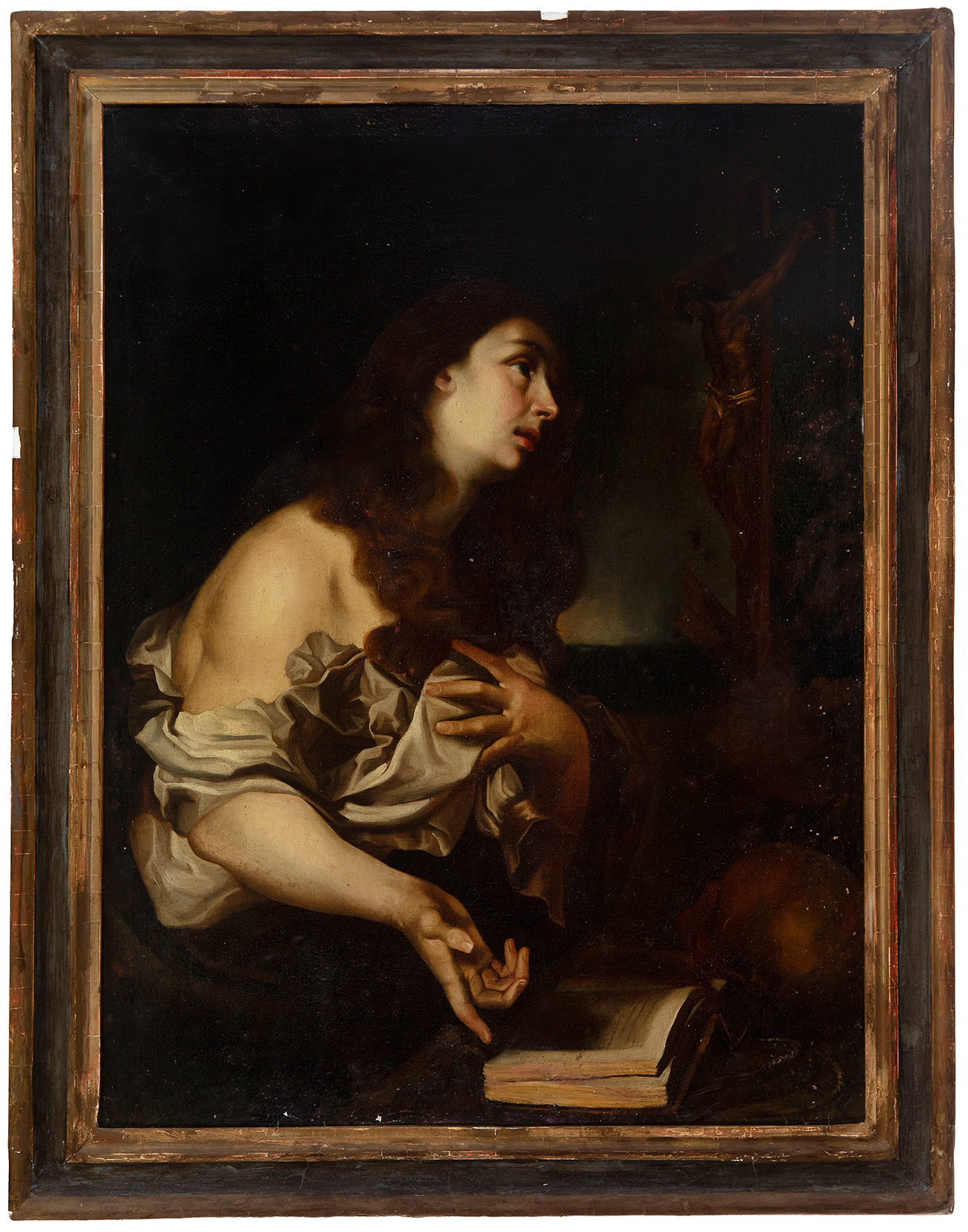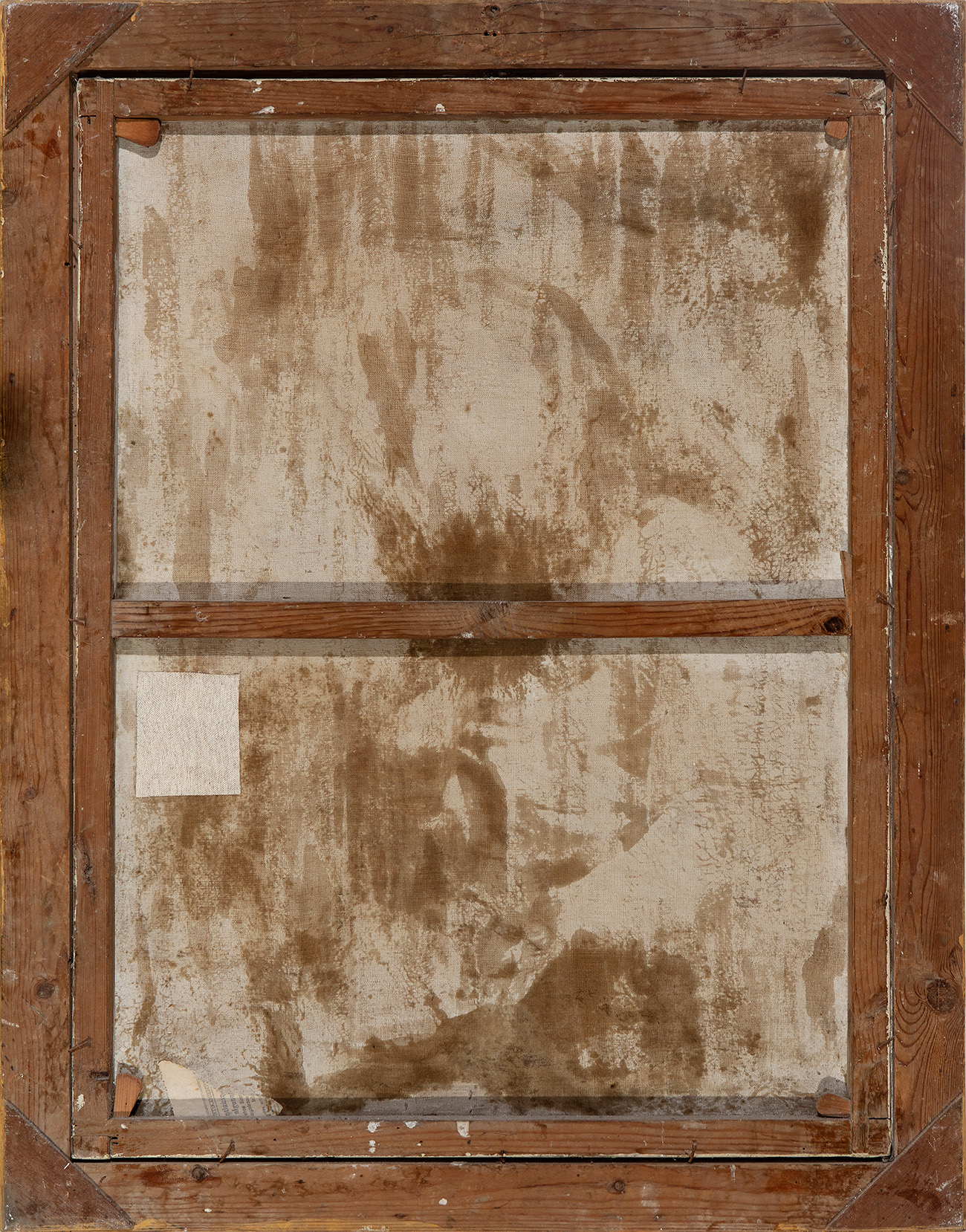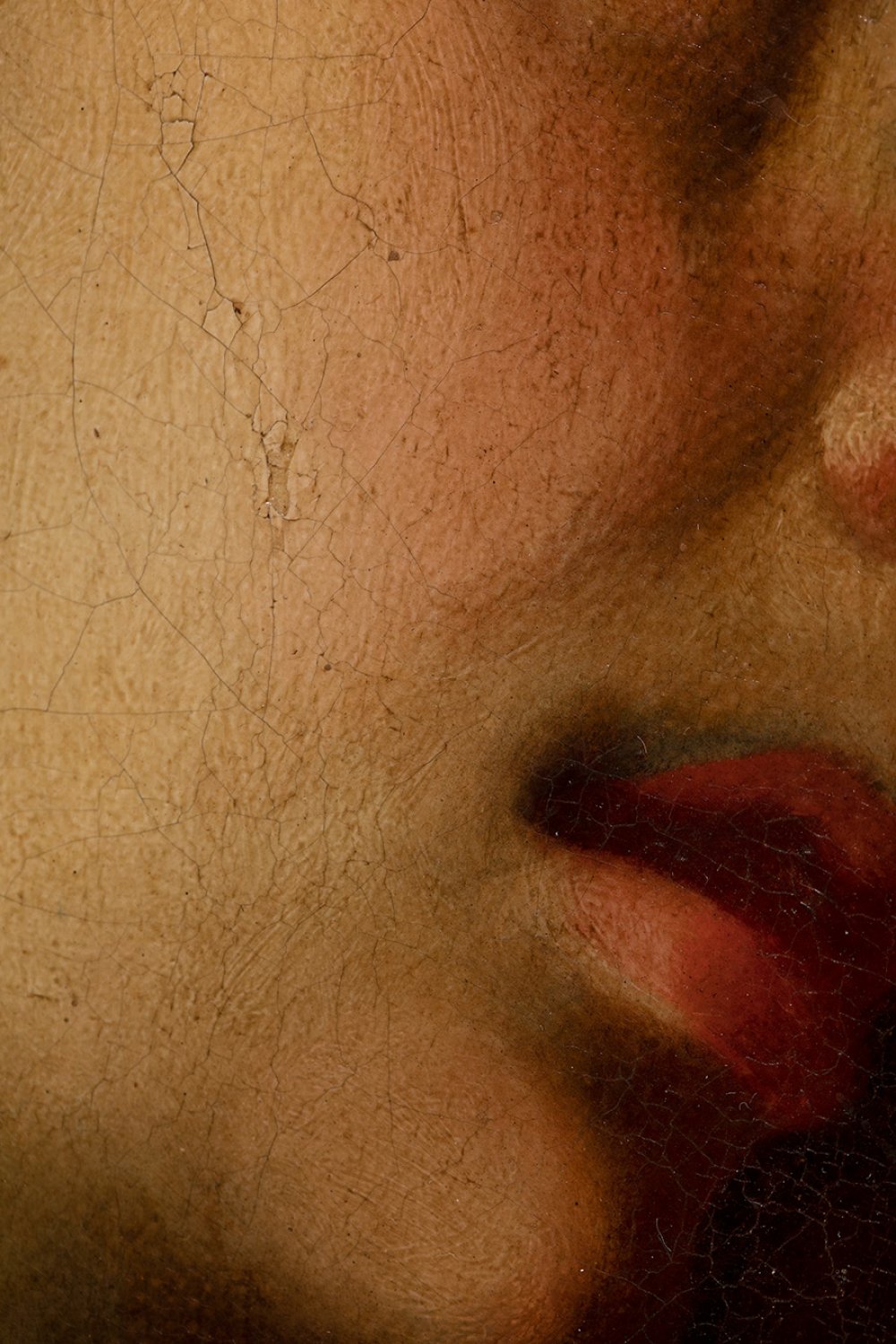16
Follower of MATEO CEREZO (Burgos, 1637-Madrid, 1666), 18th century."Penitent Magdalene".Oil on
1/5
Description
Follower of MATEO CEREZO (Burgos, 1637-Madrid, 1666), 18th century.
"Penitent Magdalene".
Oil on canvas.
Re-drawn.
It presents old restorations.
Measurements: 84 x 63 cm; 96 x 75 cm (frame).
Devotional painting representing Mary Magdalene penitent. It follows models by Mateo Cerezo, who made several versions of this theme. Specifically, the present one is based on Cerezo's "Penitent Magdalene" in the Rijksmuseum in Amsterdam. The figure, taken half-length, retains the sensuality of the original, with the blouse slipping below her shoulders but modestly covering her bust, which in Cerezo's version was semi-naked. The satiny fabric is folded in naturalistic draperies. The saint, her eyes misty with emotion, gesticulates in repentance before the open book of Scripture. The female canon here is ultimately drawn from Venetian sources, and her silky hair can be compared to that of Titian's women. In contrast to the eroticism that reminds us of her sinful life, the skull and crucifix express the ascetic ideal to which the figure prostrates herself. Intense contrasts of light, typically Baroque, construct the scene and give volume to the young woman's body.
Mateo Cerezo trained in Madrid, where he joined Carreño's workshop. He was in great demand by a varied clientele, particularly for his religious painting, although he also tackled other genres. In this respect, the treatise writer and biographer Palomino stated that he produced "still lifes with such superior excellence that no one else could surpass him", a judgement that is fully corroborated by the works in the Museo Nacional de San Carlos in Mexico, which are signed and dated. On the basis of these, Pérez Sánchez attributed to him the Kitchen Still Life purchased by the Museo del Prado in 1970, a work of evident Flemish influence that has sometimes led him to think of Pereda. The works of this artist from Valladolid have also been pointed out as Cerezo's descendants, particularly in his early creations. We know that in 1659 Cerezo was working in Valladolid, where he left somewhat rougher works than those he produced in the following decade. In his works he is a faithful follower of Carreño, with whom he became one of his best collaborators. The master showed him the path he himself later followed, following in the footsteps of Van Dyck and Titian. Thus, Cerezo developed compositions that open out into large, complex scenographies, conceived with a distinguished refinement that is evident both in the work as a whole and in the smallest details. Like the Antwerp master, he endowed his figures with a rich magnificence in their costumes, applying a fluid, light brushstroke, contrasted by a rich play of light. A superb example of all this is the Prado's The Mystical Betrothal of Saint Catherine, signed and dated 1660.
"Penitent Magdalene".
Oil on canvas.
Re-drawn.
It presents old restorations.
Measurements: 84 x 63 cm; 96 x 75 cm (frame).
Devotional painting representing Mary Magdalene penitent. It follows models by Mateo Cerezo, who made several versions of this theme. Specifically, the present one is based on Cerezo's "Penitent Magdalene" in the Rijksmuseum in Amsterdam. The figure, taken half-length, retains the sensuality of the original, with the blouse slipping below her shoulders but modestly covering her bust, which in Cerezo's version was semi-naked. The satiny fabric is folded in naturalistic draperies. The saint, her eyes misty with emotion, gesticulates in repentance before the open book of Scripture. The female canon here is ultimately drawn from Venetian sources, and her silky hair can be compared to that of Titian's women. In contrast to the eroticism that reminds us of her sinful life, the skull and crucifix express the ascetic ideal to which the figure prostrates herself. Intense contrasts of light, typically Baroque, construct the scene and give volume to the young woman's body.
Mateo Cerezo trained in Madrid, where he joined Carreño's workshop. He was in great demand by a varied clientele, particularly for his religious painting, although he also tackled other genres. In this respect, the treatise writer and biographer Palomino stated that he produced "still lifes with such superior excellence that no one else could surpass him", a judgement that is fully corroborated by the works in the Museo Nacional de San Carlos in Mexico, which are signed and dated. On the basis of these, Pérez Sánchez attributed to him the Kitchen Still Life purchased by the Museo del Prado in 1970, a work of evident Flemish influence that has sometimes led him to think of Pereda. The works of this artist from Valladolid have also been pointed out as Cerezo's descendants, particularly in his early creations. We know that in 1659 Cerezo was working in Valladolid, where he left somewhat rougher works than those he produced in the following decade. In his works he is a faithful follower of Carreño, with whom he became one of his best collaborators. The master showed him the path he himself later followed, following in the footsteps of Van Dyck and Titian. Thus, Cerezo developed compositions that open out into large, complex scenographies, conceived with a distinguished refinement that is evident both in the work as a whole and in the smallest details. Like the Antwerp master, he endowed his figures with a rich magnificence in their costumes, applying a fluid, light brushstroke, contrasted by a rich play of light. A superb example of all this is the Prado's The Mystical Betrothal of Saint Catherine, signed and dated 1660.
Auction Details
Shipping
T&Cs & Important Info
Ask seller a question
Follower of MATEO CEREZO (Burgos, 1637-Madrid, 1666), 18th century.
"Penitent Magdalene".
Oil on canvas.
Re-drawn.
It presents old restorations.
Measurements: 84 x 63 cm; 96 x 75 cm (frame).
Devotional painting representing Mary Magdalene penitent. It follows models by Mateo Cerezo, who made several versions of this theme. Specifically, the present one is based on Cerezo's "Penitent Magdalene" in the Rijksmuseum in Amsterdam. The figure, taken half-length, retains the sensuality of the original, with the blouse slipping below her shoulders but modestly covering her bust, which in Cerezo's version was semi-naked. The satiny fabric is folded in naturalistic draperies. The saint, her eyes misty with emotion, gesticulates in repentance before the open book of Scripture. The female canon here is ultimately drawn from Venetian sources, and her silky hair can be compared to that of Titian's women. In contrast to the eroticism that reminds us of her sinful life, the skull and crucifix express the ascetic ideal to which the figure prostrates herself. Intense contrasts of light, typically Baroque, construct the scene and give volume to the young woman's body.
Mateo Cerezo trained in Madrid, where he joined Carreño's workshop. He was in great demand by a varied clientele, particularly for his religious painting, although he also tackled other genres. In this respect, the treatise writer and biographer Palomino stated that he produced "still lifes with such superior excellence that no one else could surpass him", a judgement that is fully corroborated by the works in the Museo Nacional de San Carlos in Mexico, which are signed and dated. On the basis of these, Pérez Sánchez attributed to him the Kitchen Still Life purchased by the Museo del Prado in 1970, a work of evident Flemish influence that has sometimes led him to think of Pereda. The works of this artist from Valladolid have also been pointed out as Cerezo's descendants, particularly in his early creations. We know that in 1659 Cerezo was working in Valladolid, where he left somewhat rougher works than those he produced in the following decade. In his works he is a faithful follower of Carreño, with whom he became one of his best collaborators. The master showed him the path he himself later followed, following in the footsteps of Van Dyck and Titian. Thus, Cerezo developed compositions that open out into large, complex scenographies, conceived with a distinguished refinement that is evident both in the work as a whole and in the smallest details. Like the Antwerp master, he endowed his figures with a rich magnificence in their costumes, applying a fluid, light brushstroke, contrasted by a rich play of light. A superb example of all this is the Prado's The Mystical Betrothal of Saint Catherine, signed and dated 1660.
"Penitent Magdalene".
Oil on canvas.
Re-drawn.
It presents old restorations.
Measurements: 84 x 63 cm; 96 x 75 cm (frame).
Devotional painting representing Mary Magdalene penitent. It follows models by Mateo Cerezo, who made several versions of this theme. Specifically, the present one is based on Cerezo's "Penitent Magdalene" in the Rijksmuseum in Amsterdam. The figure, taken half-length, retains the sensuality of the original, with the blouse slipping below her shoulders but modestly covering her bust, which in Cerezo's version was semi-naked. The satiny fabric is folded in naturalistic draperies. The saint, her eyes misty with emotion, gesticulates in repentance before the open book of Scripture. The female canon here is ultimately drawn from Venetian sources, and her silky hair can be compared to that of Titian's women. In contrast to the eroticism that reminds us of her sinful life, the skull and crucifix express the ascetic ideal to which the figure prostrates herself. Intense contrasts of light, typically Baroque, construct the scene and give volume to the young woman's body.
Mateo Cerezo trained in Madrid, where he joined Carreño's workshop. He was in great demand by a varied clientele, particularly for his religious painting, although he also tackled other genres. In this respect, the treatise writer and biographer Palomino stated that he produced "still lifes with such superior excellence that no one else could surpass him", a judgement that is fully corroborated by the works in the Museo Nacional de San Carlos in Mexico, which are signed and dated. On the basis of these, Pérez Sánchez attributed to him the Kitchen Still Life purchased by the Museo del Prado in 1970, a work of evident Flemish influence that has sometimes led him to think of Pereda. The works of this artist from Valladolid have also been pointed out as Cerezo's descendants, particularly in his early creations. We know that in 1659 Cerezo was working in Valladolid, where he left somewhat rougher works than those he produced in the following decade. In his works he is a faithful follower of Carreño, with whom he became one of his best collaborators. The master showed him the path he himself later followed, following in the footsteps of Van Dyck and Titian. Thus, Cerezo developed compositions that open out into large, complex scenographies, conceived with a distinguished refinement that is evident both in the work as a whole and in the smallest details. Like the Antwerp master, he endowed his figures with a rich magnificence in their costumes, applying a fluid, light brushstroke, contrasted by a rich play of light. A superb example of all this is the Prado's The Mystical Betrothal of Saint Catherine, signed and dated 1660.
29th December - Old Masters
Sale Date(s)
Venue Address
Aragón 346, Barcelona
Calle Velázquez 7, Madrid
Carrer de Cirilo Amorós 55, Valencia
Barcelona
08009
Spain
General delivery information available from the auctioneer
Setdart offers Worldwide shipping
PICK UP IN ROOM: You can come and pick up your lots in our offices (Barcelona, Madrid or Valencia). At the moment of the withdrawal, you will be able to accept the current conditions of the lot by means of a document that you will sign.
YOU CAN SEND ANOTHER PERSON TO PICK UP: This person must present a signed authorization that you can find in our web page by accessing from BUY AT SETDART- LOGISTICS-DOWNLOAD AUTHORIZATION DOCUMENT. You can also send an e-mail with the requested data in AUTHORIZATION DOCUMENT to admin@setdart.com
Important Information
25% buyer´s premium
21% buyer´s premium at www.setdart.com















